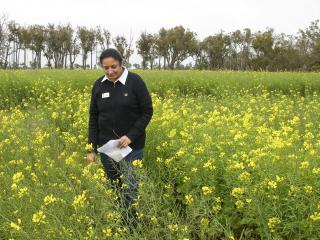Canola growers have been urged to monitor early flowering crops for the fungal disease Sclerotinia stem rot.
The Department of Primary Industries and Regional Development has warned there is an elevated risk of Sclerotinia this year as a result of cool, wet conditions suitable for Sclerotinia spore release.
Plant pathologist Ravjit Khangura said the department had already received reports of Sclerotinia apothecia, the fungal fruiting structures of the disease, and basal stem infections appearing in the northern and southern regions.
Dr Khangura said apothecia were minute and could easily be overlooked and advised growers to consider the weather conditions and paddock history when considering treatment options.
“Department research over the past few years has shown that, as a rule of thumb, the most conductive conditions for Sclerotinia spore release occur three weeks prior to flower, when more than 40 millimetres of rainfall occur, with more than 75 per cent humidity,” she said.
“For a significant level of stem infection to occur, these favourable conditions should continue at least for the next two to three weeks.
“Crops that have started flowering or about to flower are most at risk and may require fungicide treatment.
“Growers should also consider the rotation history of the paddock as well as the history of Sclerotinia in the area.”
Department research has shown a well-timed, single fungicide treatment can successfully control Sclerotinia and minimise crop losses in most cases.
Dr Khangura said timing was crucial to an effective response, however, if dry weather was forecast during the entire flowering duration, the risk of the disease is reduced.
“If wet and humid conditions prevail a few weeks before flower and the forecast is for continuous showers for the next two to three weeks, growers are advised to spray their crops at 20-50 per cent bloom, if there is a history of Sclerotinia in the paddock and the surrounding paddocks,” she said.
Two spray applications should be considered if growers have high-risk paddocks, such as those with tight rotations, heavy soil types, a dense stand of canola and in high rainfall areas where the forecast is for continuous wet conditions during flowering.
Dr Khangura said yield responses to fungicides had been variable across seasons.
“Consequently, the return on investment had also been variable ranging between $40-$225 per hectare with single fungicide application,” she said.
“Data from last year’s trial at Moonyoonooka showed a return on investment of $131 per hectare with single foliar application applied in response to favourable conditions for disease development.
“However, late applications, past 50 per cent bloom are off-label and not effective in controlling disease in most years.”
Several registered products are available to treat Sclerotinia stem rot in Western Australia, which should be applied according to label instructions – especially withholding periods for late applications.
For more information about Sclerotinia stem rot management and treatment click here.

Media contacts:
Jodie Thomson/Megan Broad, media liaison
+61 (0)8 9368 3937
